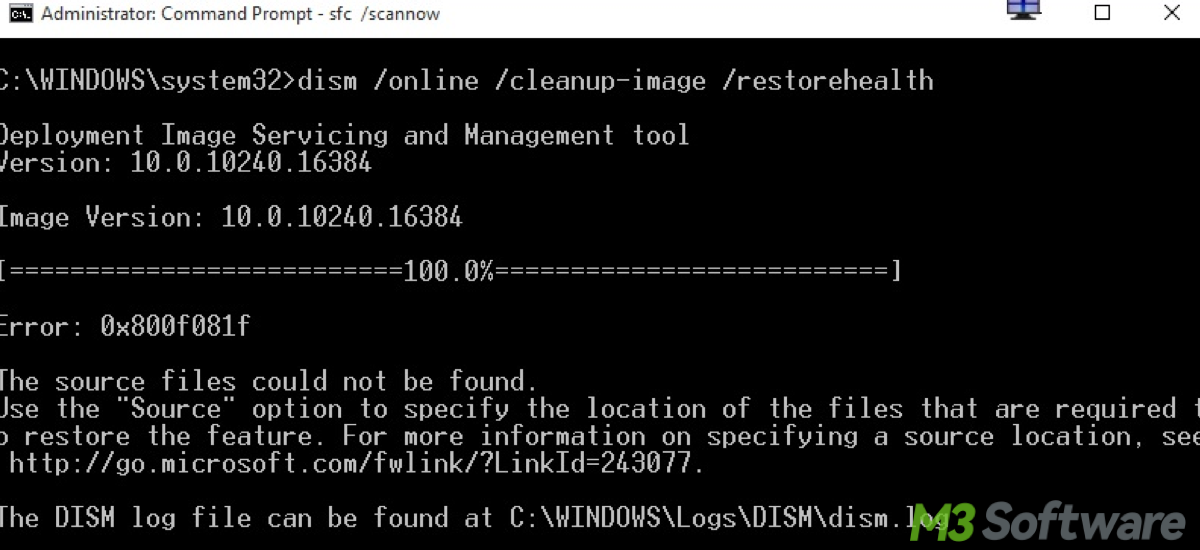Written by
Yuri ZhangDeployment Imaging Servicing and Management (DISM) is a powerful command-line tool used for servicing and managing Windows images. It functions well in repairing system files, modifying Windows features, and maintaining Windows installations.
However, DISM has limitations, and it cannot handle several tasks, which is confusing in real uses. This article outlines the specific tasks DISM cannot perform or handle and suggests alternative tools for each.

1. User account and settings management
DISM cannot manage user accounts or settings, such as creating or modifying users, setting permissions, or changing account types.
Alternative tools:
- Local Users and Groups Manager (lusrmgr.msc)
- PowerShell (New-LocalUser, Set-LocalUser)
- Control Panel → User Accounts
Note: Throughout this article, if you tend to use alternative tools, all the terms in brackets marked gray, such as lusrmgr.msc, you can run it via Win + R → type lusrmgr.msc or others→ Press Enter.
2. Software installation and uninstallation
DISM cannot install, update, or remove third-party software. It only manages Windows components and optional features.
Alternative tools:
- Windows Settings → Apps & Features
- MSI and EXE installers
- PowerShell (winget, choco, Get-Package, Uninstall-Package)
Share this and have further understanding of different tasks in Windows.
3. Backup and restore
DISM does not provide backup or restore functionalities for user files, system settings, or installed applications. It can repair system images but does not work as a backup tool.
Alternative tools:
- Windows Backup (sdclt.exe)
- File History (control /name Microsoft.FileHistory)
- System Restore (rstrui.exe)
- Backup software (iBoysoft DiskGeeker for Windows)
4. Hardware-specific issues
DISM cannot diagnose or fix hardware-related problems, such as driver conflicts, faulty components, or device errors.
Alternative tools:
- Device Manager (devmgmt.msc) for driver updates
- Event Viewer (eventvwr.msc) for hardware error logs
- PowerShell (Get-PnpDevice, Update-Driver)
5. Managing Windows boot configuration
DISM does not modify boot settings or fix boot-related issues. If the system fails to boot, other tools are required.
Alternative tools:
- BCDEdit (bcdedit.exe) – Modifies boot configuration
- Bootrec (bootrec /fixmbr, bootrec /rebuildbcd) – Fixes boot failures
- EasyBCD (third-party GUI tool for BCD editing)
6. Windows update management
While DISM can integrate updates into an image, it does not directly manage Windows Update downloads or installations.
Alternative tools:
- Windows Update (ms-settings:windowsupdate)
- PowerShell (Install-WindowsUpdate)
- Wuauclt (wuauclt /detectnow)
7. Group Policy configuration
DISM does not modify or enforce Group Policy settings. It only manages Windows image components.
Alternative tools:
- Local Group Policy Editor (gpedit.msc)
- Group Policy Management Console (gpmc.msc)
- PowerShell (Get-GPO, Set-GPRegistryValue)
8. System performance monitoring and task management
DISM does not monitor system performance, manage running processes, or optimize resource usage.
Alternative tools:
- Task Manager (taskmgr.exe)
- Performance Monitor (perfmon.exe)
- Resource Monitor (resmon.exe)
9. Disk management and partitioning
DISM cannot create, delete, resize, or format disk partitions. It only works with Windows images and component cleanup.
Alternative tools:
- Disk Management (diskmgmt.msc)
- Diskpart (diskpart.exe)
- iBoysoft DiskGeeker for Windows
When to use DISM vs. other tools
Here's a comprehensive table to untangle the misunderstanding about DISM:
| Task | Use DISM? | Alternative Tool |
| Fix corrupt system files | ✅ Yes | SFC (sfc /scannow) |
| Enable/disable Windows features | ✅ Yes | Control Panel |
| Manage Windows image (WIM/ESD) | ✅ Yes | N/A |
| Install/uninstall third-party software | ❌ No | winget, choco, MSI/EXE |
| Modify user accounts | ❌ No | lusrmgr.msc, PowerShell |
| Fix boot issues | ❌ No | bcdedit, bootrec |
| Partition or format a disk | ❌ No | diskmgmt.msc, diskpart |
Final thought
DISM is a powerful tool for servicing and repairing Windows images, but it has clear limitations. It cannot manage user settings, software, networking, passwords, or hardware-specific issues. For these tasks, other Windows utilities like SFC, PowerShell, Disk Management, and Group Policy Editor should be used. If you're troubleshooting Windows, run sfc /scannow first, then use DISM /RestoreHealth if needed. For other system tasks, choose the right tool based on the specific issue.
Spread this post to eliminate common misconceptions about DISM.
